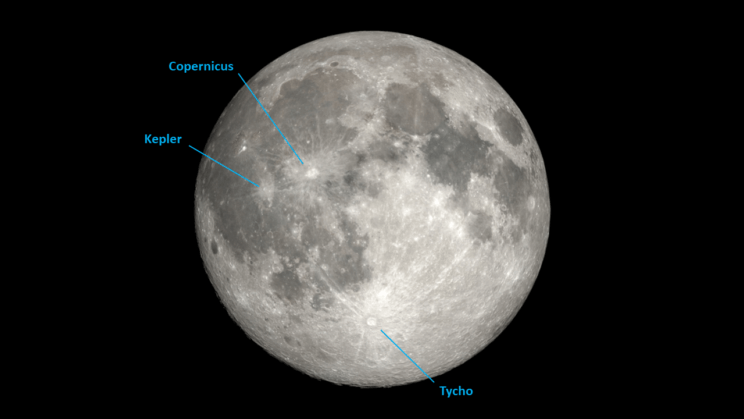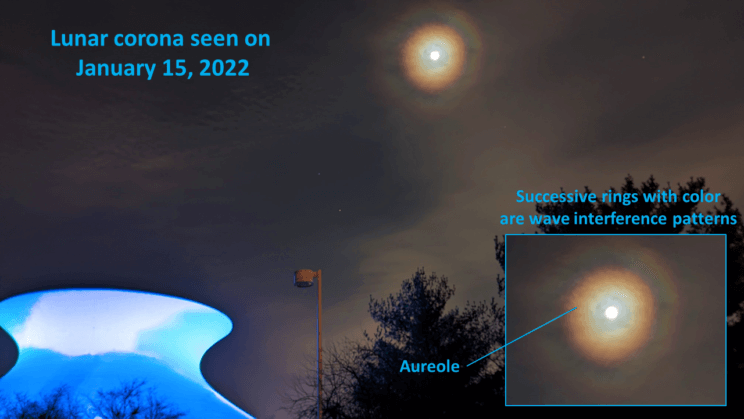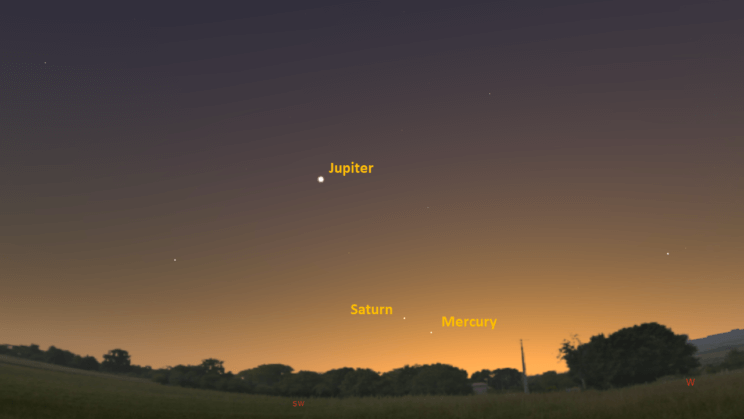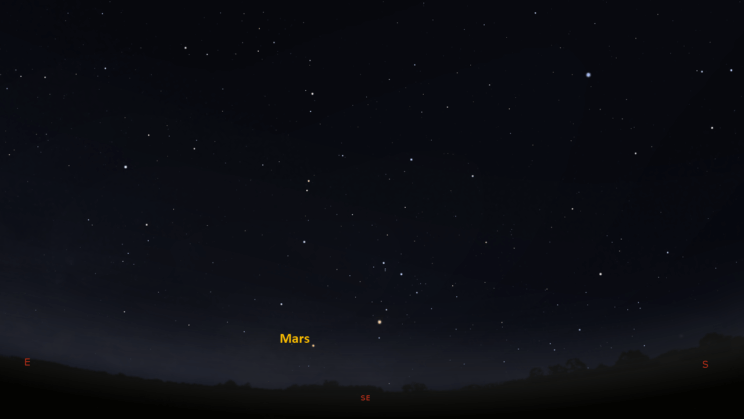This is the Saint Louis Science Center’s NIGHT SKY UPDATE for the week of Friday, January 14, 2022.
Information updated weekly or as needed.
Times given as local St. Louis time which is Central Standard Time (CST). For definitions of terminology used in the night sky update, click the highlighted text. If relying on times posted in Universal Time (UT), St. louis is -6 hours when CST.
Public Telescope Viewings
With the changing recommendations from the CDC regarding COVID-19, conversations regarding the return of star parties at the Saint Louis Science Center have begun. We are close to bringing back our public telescope viewings, but a few details still need to be worked out. We will post future updates as we learn more about when we can bring back telescope viewings.
Observing Highlight of the Week

Full moon occurs on January 17, 2022. This is a good opportunity to track down rayed craters such as Tycho, Copernicus and Kepler. Image credit: NASA, SVS, Ernie Wright.
Last week we explored the Moon around its first quarter phase. This week the Moon reaches full moon on January 17, 2022. When near full moon, the Moon will offer us a different kind of observing experience.
As we mentioned last week, the Moon was humanity’s original time piece. It takes the Moon 29.5 days to complete its cycle of phases which is called a synodic cycle. This cycle is still connected to many world traditions. One such example is the Viking tradition of Jol or what most know as Yule. Traditionally, Jol starts with the first full lunar cycle after the winter solstice. It ends at full moon with the feast of Jólablót. Observing the Moon was a way for ancient cultures to keep track of how things changed. The traditions many cultures celebrate are a byproduct of this knowledge.
Visually, full moon offers a very different visual experience due to its bright appearance. When at full moon, the Moon is in opposition with the Sun. In other words, it appears near the antisolar point in the sky. What results from this is called the opposition effect. When near the antisolar point, shadows cast by features on the lunar surface are pointed away from us. This drastically diminishes the ratio of dark spaces to light spaces causing the Moon to appear brighter. Stepping outside on a clear night near full moon can be surprising. It will be bright enough that objects will cast shadows. This is problematic for many aspects of stargazing. Even the Moon will look a little different due to the contrast of the lunar surface.
With the loss of much of the fine details, full moon is a good time to track down rayed craters. These are often geologically young impact sites that display rays of ejected material emanating away from the crater. A classic rayed crater is Tycho. Often described as the Moon’s naval, it appears in the middle southern half of the Moon’s near side. Samples of material ejected from crater Tycho collected during the Apollo 17 mission indicate the impact occurred 108 million years ago. Being relatively young, Tycho’s crater rim and central peak are still well intact. The central peak in the center of crater Tycho is visible in binoculars. Two other prominent rayed craters are named Copernicus and Kepler. Both are found in the large lunar mare called Oceanus Procellarum.
Aside from direct views the Moon, if there are nights this week with high altitude clouds, it will be a good time to track down atmospheric optics. Much like in the daytime, sunlight entering Earth’s atmosphere can be distorted in interesting ways. A rainbow and the blue color of our day sky are common examples of how sunlight is distorted by our atmosphere. At night when we see the Moon, we are seeing sunlight reflect off the lunar surface. As the light enters our atmosphere, it too can be distorted. Coronal effects and lunar halos are common examples of nighttime atmospheric optics. These are more common when the Moon is near full moon. To learn more about atmospheric optics visit https://www.atoptics.co.uk/atoptics/oppos1.htm

Lunar corona seen on January 15, 2022. Clouds still present after the snow that fell in St. Louis caused sunlight reflecting off the Moon to be diffracted. When coronae occur, the Sun or Moon will appear to be surrounded by a bright glow called and aureole. Surrounding this, fainter rings of light displaying the colors of a rainbow will often be seen. The appearance of these are caused by interference patterns. Image credit: Eric Gustafson.
The Sun and Moon

The Moon as seen from the International Space Station, on July 31, 2011.
Credit: NASA
Sunrise is at 7:17 a.m. on Friday, January 14 and sunset is at 5:03 p.m. providing us with close to 10 hours of daylight. Even after sunset, the light from the Sun will dimly illuminate our sky for roughly 1 hour and 30 minutes. This period is called twilight, which ends around 6:37 p.m. this week. For those with a sundial, local noon occurs around 12:09 a.m. this week.
| Day | Sunrise | Sunset |
|---|---|---|
| 2022-01-14 | 7:17 a.m. | 5:03 p.m. |
| 2022-01-15 | 7:17 a.m. | 5:04 p.m. |
| 2022-01-16 | 7:17 a.m. | 5:05 p.m. |
| 2022-01-17 | 7:16 a.m. | 5:06 p.m. |
| 2022-01-18 | 7:16 a.m. | 5:07 p.m. |
| 2022-01-19 | 7:15 a.m. | 5:08 p.m. |
| 2022-01-20 | 7:15 a.m. | 5:09 p.m. |
| 2022-01-21 | 7:14 a.m. | 5:10 p.m. |
| 2022-01-22 | 7:14 a.m. | 5:11 p.m. |
Moon
Moonrise for Friday, January 14 occurs at 2:14 p.m. and moonset will occur at 5:42 a.m. on the following day. On Friday, January 14 the Moon will exhibit a waxing gibbous phase with 92% of the lunar disk illuminated. January’s full moon occurs on January 17, 2022.
International Space Station (ISS) Observing

Visible passes of ISS from St. Louis for the week of January 14 occur during evening hours. The best passes this week occur the evenings of January 18 and 19. Use the table below for information about these and other visible passes this week.
Catch ISS from St. Louis starting Friday, January 14
| Date | Starts | Max. altitude | Ends | |||||||
|---|---|---|---|---|---|---|---|---|---|---|
| Time | Alt. | Az. | Time | Alt. | Az. | Time | Alt. | Az. | ||
| 16 Jan | -2.9 | 18:58:08 | 10 | SW | 19:00:34 | 44 | SSW | 19:00:34 | 44 | SSW |
| 17 Jan | -3 | 18:10:31 | 10 | SSW | 18:13:37 | 37 | SE | 18:15:00 | 25 | E |
| 18 Jan | -2.7 | 18:59:17 | 10 | WSW | 19:02:18 | 38 | NW | 19:02:18 | 38 | NW |
| 19 Jan | -3.5 | 18:11:09 | 10 | WSW | 18:14:27 | 66 | NW | 18:16:34 | 20 | NE |
| 20 Jan | -1.6 | 19:01:09 | 10 | WNW | 19:03:37 | 19 | NNW | 19:03:43 | 19 | NNW |
| 21 Jan | -2.1 | 18:12:39 | 10 | W | 18:15:31 | 26 | NNW | 18:17:52 | 13 | NNE |
Magnitude (Mag): The Measure of brightness for a celestial object. The lower the value is, the brighter the object will be.
Altitude (Alt): The angle of a celestial object measured upwards from the observer’s horizon.
Azimuth (Az): The direction of a celestial object, measured clockwise from an observer’s location with north being 0°, east being 90°, south being 180° and west being 270°.
For information about ISS flyovers and other visible satellites, visit www.heavens-above.com
Detailed information regarding all unmanned exploration of our universe, missions past, present, and planned, can be found at Jet Propulsion Laboratories:
The Visible Planets

Looking southwest, at 5:30 p.m. January 14, 2022. Credit: Stellarium, EG

Looking southeast, at 6:00 am, January 15, 2022. Credit: Stellarium, EG
This week, four naked eye planets are visible. Mercury, Jupiter and Saturn are visible in the southwest after sunset. Mars is still tough to see but it is steadily climbing out of the Sun’s glare in the east before sunrise.
Mercury
The current evening apparition of Mercury is beginning to end. Mercury will be found 7° above the southwestern horizon 30 minutes after sunset. By January 18, 2022, Mercury will only by 3° above the horizon 30 minutes after sunset. This means for most of us we only have couple of days remaining to see the elusive planet before it slips into the tree line. Mercury reaches inferior conjunction on January 23, 2022, and as such if you look for Mercury later this week, make absolute sure the Sun has set.
Mars
A new apparition for Mars has begun. Mars rises at 5:13 a.m. Start looking for Mars around 6:00 a.m. as it clears trees and buildings. Mars will continue to climb out of the Sun’s glare as it heads towards opposition later this year on December 7, 2022.
Jupiter
Look for Jupiter in the southwest as it starts to darken outside. Jupiter sets at 8:08 p.m. and will set about 20 minutes earlier each week. Jupiter reaches superior conjunction on March 5, 2022.
Saturn
Saturn is visible about 20 minutes after sunset in the southwest. Saturn sets at 6:28 p.m. Saturn will reach superior conjunction on February 4, 2022.
James S. McDonnell Planetarium
Night Sky Update: January 14 – January 22, 2022






